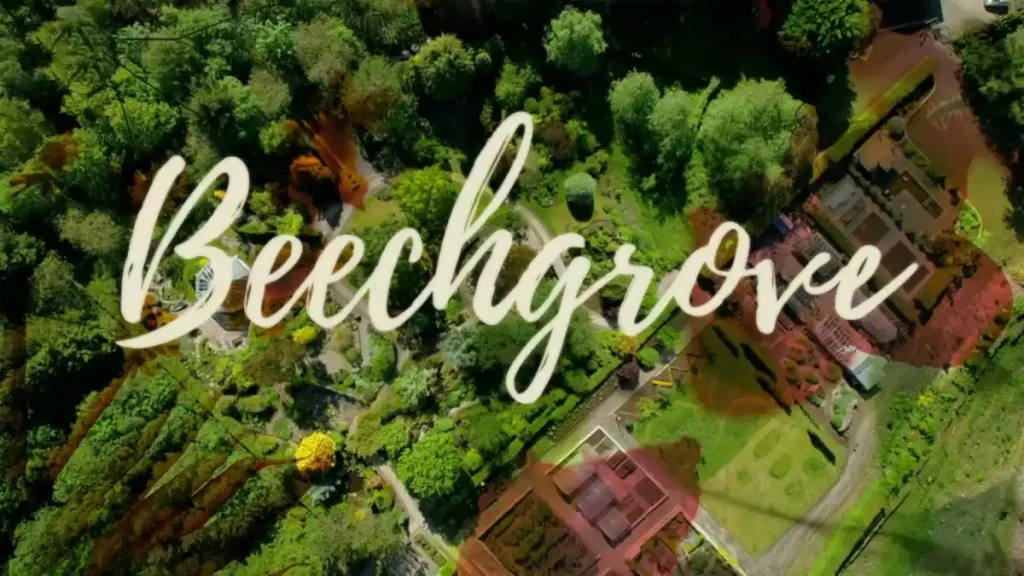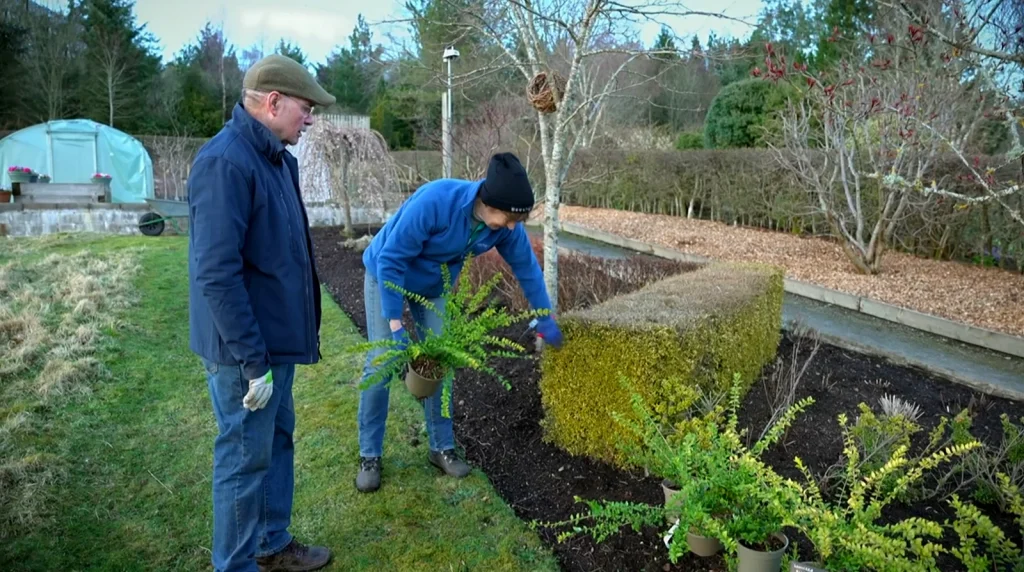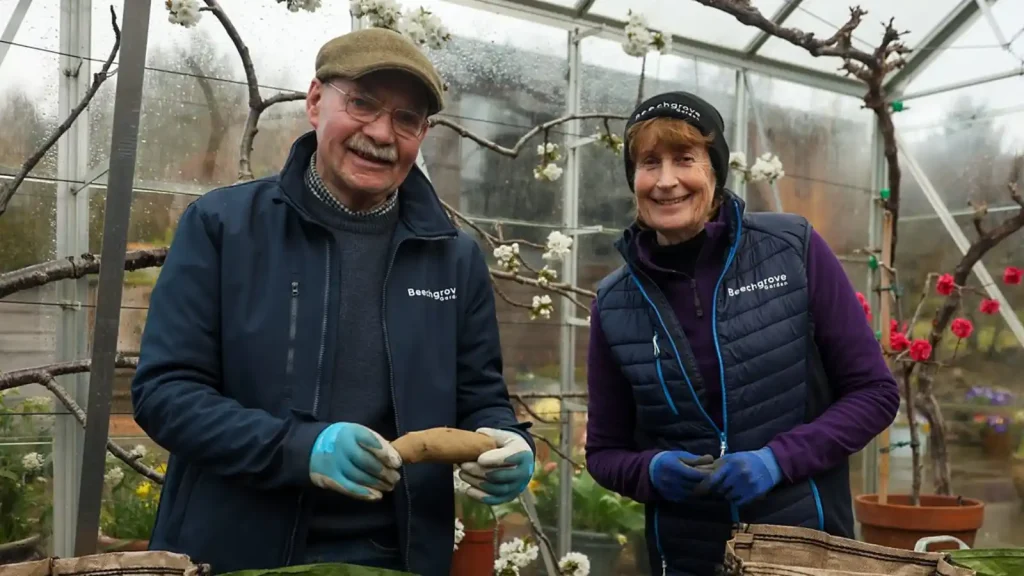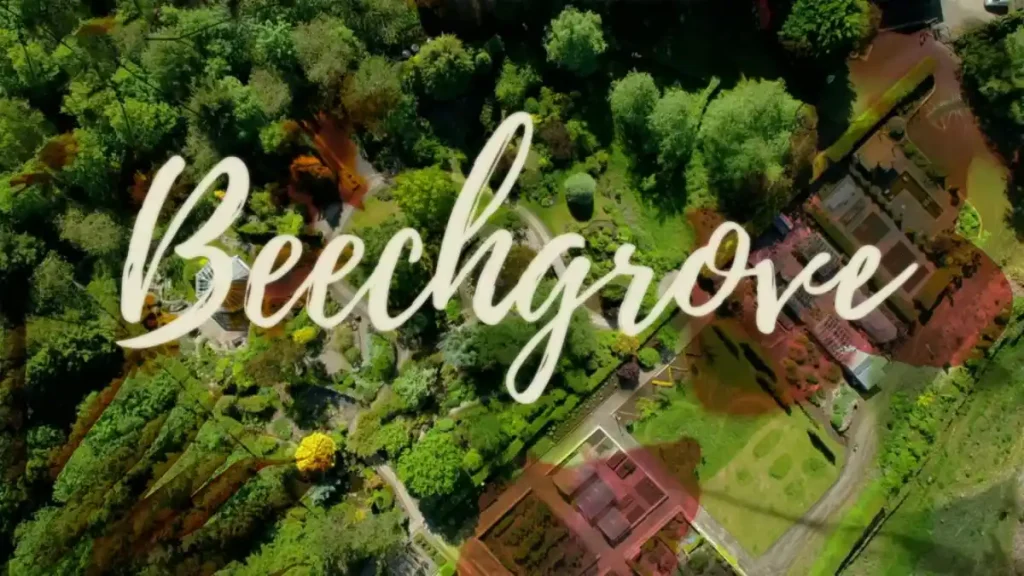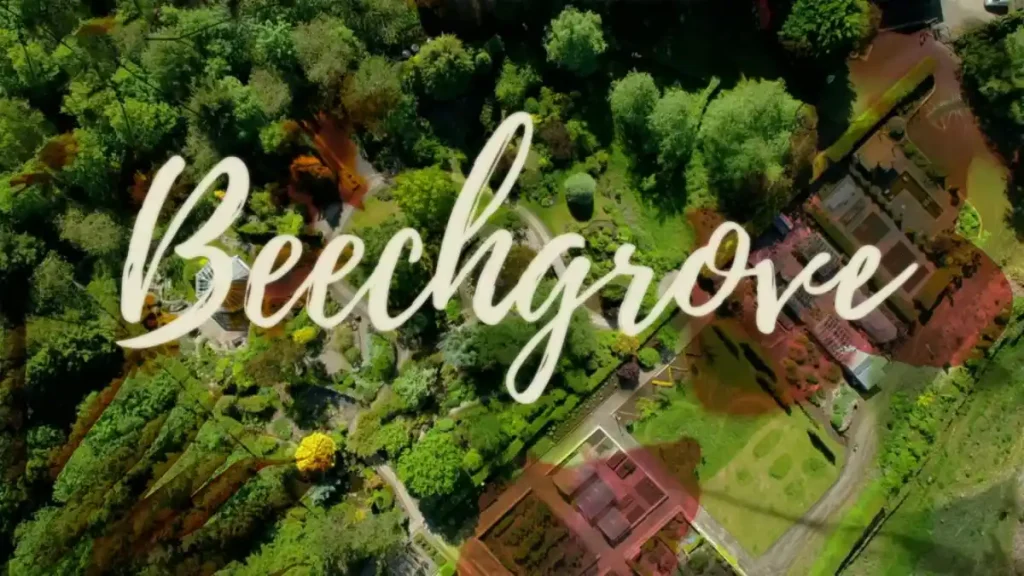In The Beechgrove Garden 2024 episode 21, the results of months of diligent effort in the garden are finally beginning to show. As summer progresses, the team at Beechgrove is eager to assess how their crops are faring. Carole Baxter takes center stage in one of Beechgrove Garden’s greenhouses, where she carefully evaluates this season’s tomato crop. The question on everyone’s mind is whether the varieties planted earlier in the year have thrived under this season’s conditions. Tomatoes, often considered a staple in many home gardens, can be particularly sensitive to environmental factors, making this assessment crucial for both the garden and its viewers.
Alongside Carole, Ruth Vichos takes on the task of examining another key crop—this year’s blight-resistant potatoes. Given the damp summer, the conditions have been ripe for the spread of blight, a disease that can devastate potato plants. The experiment this year focuses on whether these specially bred blight-resistant varieties will live up to their promise. With the potential to revolutionize how home gardeners approach potato cultivation, the results of this test could be significant. Ruth will be closely monitoring the potatoes to determine if the breeding efforts have truly paid off, providing viewers with valuable insights for their gardens.
Meanwhile, over at Old Scone, Brian Cunningham turns his attention to a different aspect of gardening—fruit trees. He’s been nurturing some newly planted apple trees and shares his expertise on how to get the best results when planting bare-root plants. This method, often favored by experienced gardeners, requires precise timing and care to ensure the trees establish well and produce a healthy crop in the years to come. Brian’s advice is practical and timely, offering viewers a chance to learn the best practices for their own fruit trees, just as many are considering their autumn planting plans.
As always, the episode is packed with the usual handy hints and expert gardening advice that has made The Beechgrove Garden a beloved resource for gardeners of all skill levels. Whether it’s tips on pest control, ideas for seasonal planting, or guidance on maintaining a healthy garden, the show continues to deliver valuable content that helps viewers make the most of their outdoor spaces. With the season’s challenges and rewards on full display, episode 21 is not to be missed by anyone looking to enhance their gardening knowledge and experience.
The Beechgrove Garden 2024 episode 21
Transforming Your Garden: From Bland to Grand
The Power of Thoughtful Garden Design
Imagine stepping into your backyard and being transported to a lush, vibrant oasis. This isn’t just a dream – it’s the potential lying dormant in every garden, waiting to be unleashed through thoughtful design. Like an artist with a blank canvas, you have the power to transform your outdoor space into a masterpiece that reflects your personality and nurtures your soul.
Think of your garden as a living, breathing entity. It’s not just about planting a few flowers here and there; it’s about creating an ecosystem that thrives and evolves with each passing season. By carefully considering elements like color, texture, and form, you can craft a landscape that’s not only visually stunning but also functionally harmonious.
Embracing Wildlife-Friendly Spaces
Gone are the days when a pristine, manicured lawn was the pinnacle of garden perfection. Today, savvy gardeners are recognizing the beauty and benefits of inviting nature’s creatures into their outdoor sanctuaries. Picture a garden buzzing with bees, fluttering with butterflies, and alive with the gentle rustling of hedgehogs in the undergrowth.
Creating a wildlife-friendly garden is like extending an open invitation to nature’s most fascinating guests. By incorporating native plants, installing water features, and providing shelter, you’re not just beautifying your space – you’re contributing to the local ecosystem. It’s a win-win situation where your garden becomes a haven for both you and the local wildlife.
Seasonal Opportunities for Garden Enhancement
Your garden is a dynamic canvas, changing with the ebb and flow of the seasons. Each new season brings fresh opportunities to elevate your outdoor space. Spring whispers promises of new growth, summer bursts with vibrant blooms, autumn paints the landscape in warm hues, and winter reveals the subtle beauty of structure and form.
Embracing these seasonal shifts is like conducting a year-long symphony in your backyard. By planning and planting with all four seasons in mind, you ensure that your garden never misses a beat. From early spring bulbs to late-blooming perennials, from summer fruit trees to winter-interest shrubs, there’s always something to look forward to in a well-designed garden.
Moreover, each season offers unique chances to fine-tune your garden’s performance. Spring is perfect for laying new pathways or building raised beds. Summer allows you to assess and adjust your watering systems. Autumn is ideal for dividing perennials and planting spring-flowering bulbs. Even winter has its gardening gems, like pruning deciduous trees and planning next year’s vegetable plot.
By tuning into these seasonal rhythms, you’re not just maintaining your garden – you’re continually improving and evolving it. It’s an ongoing journey of discovery, where each year brings new insights and opportunities for growth. So, roll up your sleeves and get ready to orchestrate a year-round spectacle in your very own backyard paradise.
Cultivating Success: Expert Techniques for Fruit and Vegetable Growing
Mastering the Art of Strawberry Cultivation
Picture this: you’re biting into a sun-warmed, perfectly ripe strawberry, its sweet aroma filling the air. Now, imagine that strawberry came from your very own garden. Sounds enticing, doesn’t it? Well, with a little know-how and some tender loving care, you can turn this dream into a delicious reality.
Strawberries are like the prima donnas of the fruit world – they demand attention, but boy, do they reward you for it! The key to a bountiful strawberry harvest lies in understanding their quirks and catering to their needs. From selecting the right varieties to providing optimal care, every step in your strawberry journey is crucial.
Selecting the Right Varieties for Extended Harvests
When it comes to strawberries, variety is indeed the spice of life. By carefully choosing a mix of early, mid-season, and late varieties, you can transform your garden into a strawberry smorgasbord that keeps producing from early summer right through to autumn. It’s like orchestrating a fruity symphony that plays all season long!
Consider planting early varieties like ‘Honeoye’ or ‘Earliglow’ for that first burst of berry bliss. Follow up with mid-season stars such as ‘Elsanta’ or ‘Jewel’ to keep the momentum going. Finally, round off your berry bonanza with late-season delights like ‘Malwina’ or ‘Florence’. This strategic planting ensures you’re never far from your next strawberry fix.
First-Year Care Tips for Optimal Growth
Strawberries may be perennials, but their first year in your garden is like their freshman year at college – it sets the stage for future success. During this crucial time, your focus should be on helping your plants establish strong roots and healthy foliage. Think of it as laying the groundwork for years of fruitful harvests to come.
Start by preparing a sunny, well-draining bed enriched with organic matter. This is like creating the perfect dorm room for your strawberry plants – a place where they can thrive and grow. When planting, ensure the crown (where the leaves emerge) sits just above soil level. Too deep, and you risk rot; too high, and the roots may dry out.
Greenhouse Glory: Maximizing Your Indoor Growing Space
Tomato Trials: Comparing Classic and New Varieties
Step into your greenhouse, and you’re entering a world of endless possibilities. The air is thick with potential, and nowhere is this more evident than in the realm of tomato growing. Whether you’re a seasoned gardener or a green-thumbed novice, there’s something undeniably exciting about nurturing these juicy red gems to perfection.
But why settle for the same old varieties when there’s a whole universe of tomato flavors waiting to be explored? By conducting your own tomato trials, you’re not just growing food – you’re embarking on a delicious adventure. Imagine the thrill of biting into a sun-warmed tomato that you’ve nurtured from seed, its flavor a perfect balance of sweetness and acidity that you’ve carefully curated.
Timing Your Harvest for Peak Flavor
Timing, as they say, is everything – and this couldn’t be truer when it comes to harvesting tomatoes. The key to unlocking the full potential of your greenhouse-grown beauties lies in understanding the subtle signs of peak ripeness. It’s like being a detective, but instead of solving crimes, you’re cracking the code of perfect flavor.
First off, forget everything you’ve been told about color being the sole indicator of ripeness. While a deep, uniform red (or whatever color your chosen variety should be) is indeed important, it’s just part of the story. Gently squeeze your tomatoes – they should yield slightly to pressure but still feel firm. A tomato that’s too soft is likely overripe, while one that’s rock-hard needs more time on the vine.
Don’t be afraid to use your nose, either. A ripe tomato should have a sweet, earthy aroma at the stem end. If you can’t smell anything, it’s probably not ready yet. And remember, patience is a virtue – rushing to harvest can mean missing out on that perfect moment of flavor explosion.
Late-Season Care for Optimal Ripening
As the days grow shorter and the air takes on that crisp autumn feel, your greenhouse tomatoes enter their final push towards deliciousness. This is when your tender loving care can make all the difference between a good harvest and a great one. Think of it as the last leg of a marathon – your plants have come so far, and now it’s time to help them cross the finish line in style.
Start by giving your plants a good once-over. Remove any yellowing or diseased leaves to help prevent the spread of late-season blight. This not only keeps your plants healthier but also improves air circulation, which is crucial for preventing fungal issues in the cooler, damper conditions of late summer and early autumn.
Next, consider your watering routine. As the season winds down, your tomato plants need less water. Reducing watering can actually stress the plants just enough to encourage them to ripen their remaining fruit faster. It’s like giving them a gentle nudge towards the finish line.
Don’t forget about temperature control. While your greenhouse offers protection from the elements, it’s important to maintain a balance. On sunny days, ensure proper ventilation to prevent overheating. On cooler nights, you might need to provide some extra warmth to keep the ripening process on track.
Finally, if you find yourself with stubborn green tomatoes as the season draws to a close, don’t despair. Harvest them and bring them indoors to ripen. Place them in a paper bag with a ripe banana – the ethylene gas released by the banana will encourage your tomatoes to ripen, ensuring not a single fruit goes to waste.
By mastering these late-season care techniques, you’re not just growing tomatoes – you’re orchestrating a grand finale of flavor that will have you savoring the fruits of your labor well into the cooler months. So roll up your sleeves, tend to your greenhouse gems, and get ready for a tomato harvest that’s truly worth writing home about!
In their first growing season, it’s tempting to let your plants fruit. However, pinching off those first blossoms is like sending your plants to the gym – it might seem counterintuitive, but it helps them build strength for future productivity. This sacrifice pays off in spades come next season when your plants reward you with a bumper crop of berries.
Remember, strawberries are thirsty plants. Regular watering, especially during fruit formation, is crucial. Think of it as nurturing their potential – with each drink, you’re helping those future berries swell to juicy perfection. Mulching around your plants not only helps retain moisture but also keeps those precious berries off the soil, preventing rot.
By following these expert techniques, you’re not just growing strawberries – you’re cultivating a delicious tradition that will bring joy to your garden (and your taste buds) for years to come. So roll up your sleeves, get your hands dirty, and prepare for the sweet rewards of strawberry success!
Conclusion The Beechgrove Garden 2024 episode 21: Embracing the Joy of Year-Round Gardening
The Rewards of Continuous Learning and Experimentation
Gardening is a journey, not a destination. It’s a lifelong adventure that unfolds season after season, offering endless opportunities for growth – both for your plants and for you as a gardener. Every success, every failure, and every unexpected twist in your garden story contributes to your horticultural wisdom.
Think of your garden as a living laboratory. Each plant you nurture, each technique you try, is an experiment in progress. Sometimes, your efforts will yield spectacular results – a bumper crop of juicy tomatoes or a breathtaking display of colorful blooms. Other times, things might not go as planned. But even in failure, there’s a valuable lesson waiting to be unearthed.
Embrace these learning moments with open arms and an inquisitive mind. Did your prized roses succumb to black spot? Don’t despair! Instead, dive into research about organic fungicides or resistant varieties. Was your vegetable harvest less bountiful than expected? Use this as motivation to explore new composting techniques or innovative companion planting strategies.
Remember, even the most seasoned gardeners are constantly learning and adapting. Gardening trends evolve, new plant varieties emerge, and climate patterns shift. By staying curious and open to new ideas, you’re not just maintaining a garden – you’re cultivating a rich, ever-expanding knowledge base that will serve you well for years to come.
Planning Ahead: Setting the Stage for Next Season’s Success
As one gardening season winds down, another beckons on the horizon. This cyclical nature of gardening offers a unique opportunity to reflect, learn, and plan for an even more spectacular growing season ahead. It’s like being the director of your own horticultural production – the curtain may have fallen on this year’s performance, but it’s time to start scripting next year’s show-stopping garden extravaganza.
Start by taking stock of what worked well and what could use improvement. Did your new raised bed vegetable garden exceed expectations? Make notes on which varieties thrived and which struggled. Was your perennial border lacking in late-summer interest? Jot down ideas for plants that could fill that seasonal gap.
Now, let your imagination run wild as you envision next year’s garden. Flip through seed catalogs, browse gardening websites, or visit local nurseries for inspiration. Perhaps you’ll decide to experiment with a new color scheme in your flower beds, or maybe you’ll take the plunge into growing exotic vegetables. The possibilities are as endless as your creativity!
Don’t forget the practical aspects of planning, too. Winter is the perfect time to maintain and repair garden structures, sharpen tools, and take stock of your seed inventory. By tackling these tasks now, you’ll hit the ground running when spring arrives.
Most importantly, approach your garden planning with joy and anticipation. Let the promise of next season’s blooms and harvests fill you with excitement. After all, gardening is more than just a hobby – it’s a celebration of life, growth, and the endless cycle of seasons. So grab your garden journal, pour yourself a cup of tea, and start dreaming up your most beautiful, bountiful garden yet. The seeds of next year’s success are waiting to be sown in your imagination today!
F.A.Q. The Beechgrove Garden 2024 episode 21
Q.: What is the main theme of The Beechgrove Garden 2024 episode 21?
A.: Episode 21 focuses on evaluating the progress of various crops planted earlier in the year, with a focus on tomatoes and blight-resistant potatoes. Brian Cunningham also provides insights into planting bare-root fruit trees.
Q.: Who are the key gardening experts featured in this episode and what are their areas of expertise?
A.: Carole Baxter is focused on evaluating the tomato crop, while Ruth Vichos examines the blight-resistant potatoes. Brian Cunningham shares his knowledge about planting and caring for bare-root fruit trees.
Q.: What are some of the challenges and rewards associated with this year’s gardening season as showcased in the episode?
A.: The damp summer has created a challenge in managing potato blight, while the team also assesses the impact of seasonal conditions on the tomato crop. The episode highlights the potential rewards of growing blight-resistant potato varieties and successfully planting bare-root fruit trees.
Q.: How does The Beechgrove Garden cater to viewers of all skill levels?
A.: The show offers a range of practical tips and expert advice, covering topics like pest control, seasonal planting, and general garden maintenance. This comprehensive approach makes the show valuable for both experienced and novice gardeners.
Q.: What are the key takeaways for viewers from The Beechgrove Garden 2024 episode 21?
A.: Viewers gain insights into the performance of different crops in specific growing conditions, learn techniques for planting bare-root fruit trees, and receive practical advice on various aspects of gardening, including pest control and seasonal planting.
